Thin and crispy jalebi is everyone's undoing. Make them at home now with easy step by step instructions that'll give you the best homemade jalebis every single time.
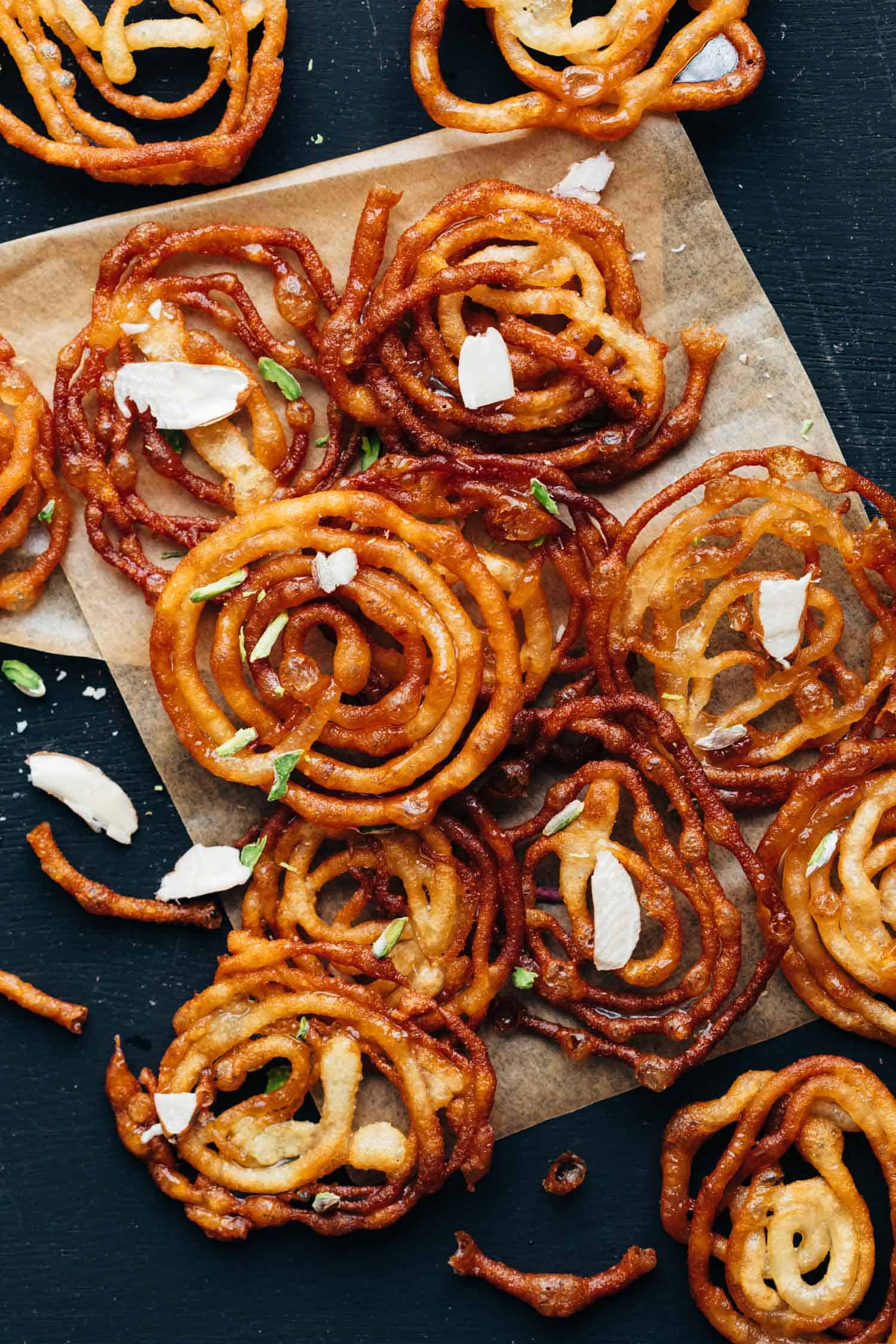
I definitely have a weakness for homemade jalebis and have eaten them by the kilo in a single sitting. And here's the thing - I only eat HOMEMADE jalebi. If you ever offer me anything but the jalebis that my mum makes, it'll be a resounding no. I won't even get tempted because they are THAT GOOD.
And that's why she is sharing her recipe here today. And it's so worth it.
Like chicken biryani, jalebi is another dish that I have always been intimidated by because it just seems like a complicated process. But wait til you read the recipe.
Quick Walk Through: Homemade Jalebis
Reasons why you're going to love this recipe
Unlike what you might think, you can make jalebi at home without breaking a sweat. I have step by step instructions to make homemade jalebi, but in summary here's why:
- It only needs six ingredients. The seventh ingredient is water which doesn't really count as an actual ingredient. I bet all of these six ingredients, except saffron (maybe) are in your pantry so you don't need to go buy anything special for this recipe.
- The maximum time required for this recipe is 'resting time'. The jalebi batter of flour and yogurt needs time to rest and ferment. The rest is fairly quick.
- The shape of the jalebi doesn't matter. Really! I know we've always seen perfectly spiral jalebis. But bite into an imperfect one, and it will taste the same.
- The thickness of jalebis matter. That determines whether the jalebis will taste light and crisp, or thick and syrupy. Traditionally, cloth was used to hold the jalebi batter and a hole was made in the center for the batter to come out. But we are using a regular squeezy bottle which has the perfect sized hole for the right thickness. Just hold the bottle 2-3 inches above the oil for the batter to fall out into a thin stream for thin, crisp jalebis.
- If you are a newbie, try to measure the temperature of the oil and sugar syrup. This an important step which will again determine if your jalebis will be thin and crispy. The temperature of the oil should be maintained at 176C/350F, which will ensure that the batter immediately comes up to the surface and cooks just right. The sugar syrup should get to 100C/ 212F and shouldn't reach the one thread consistency or the sugar will form a thick layer on the outside which is not appetizing at all.
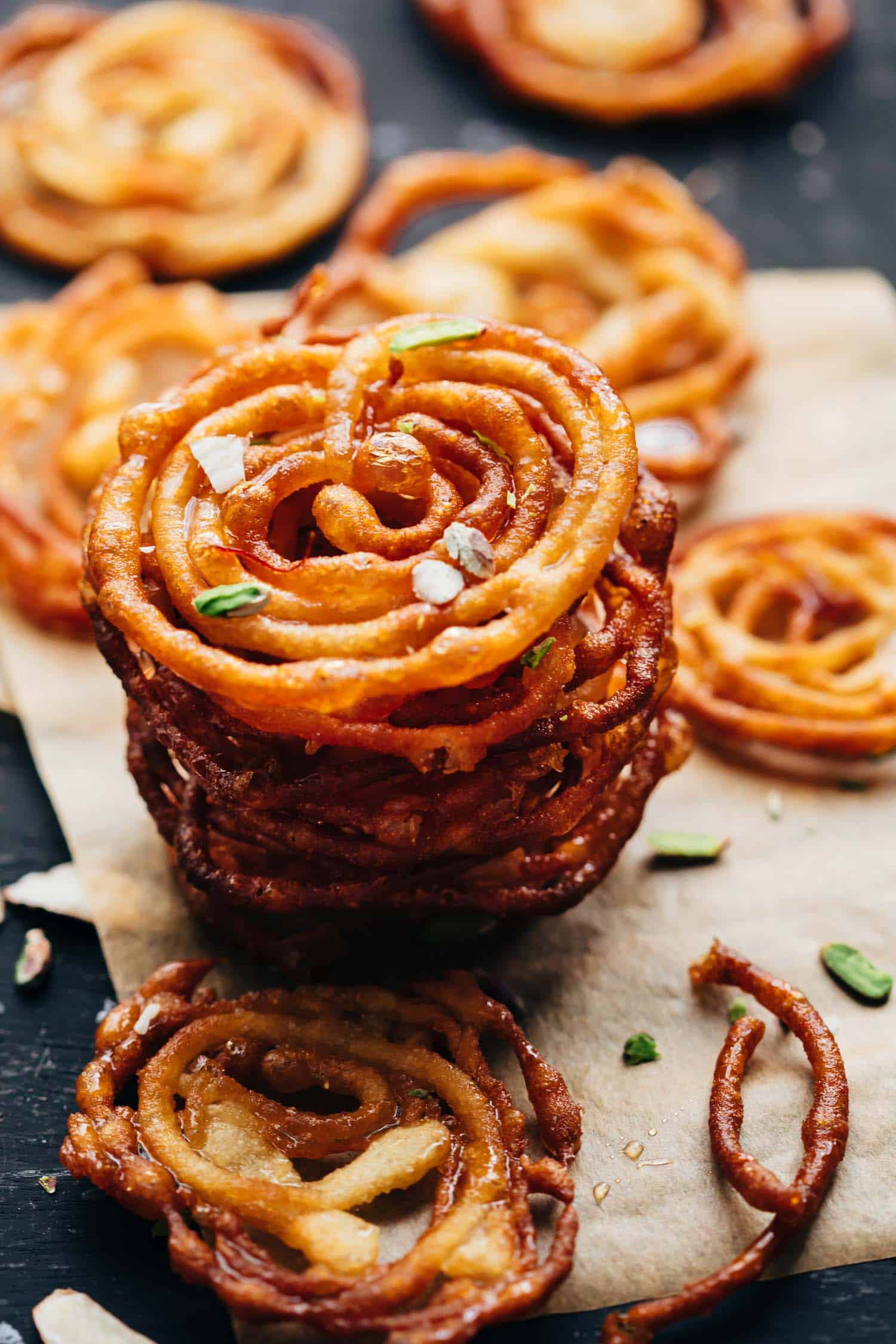
Five easy steps to making Homemade Jalebi
Levain: The levain or batter of the jalebi is made with all purpose flour, yogurt (homemade curd in India) and water. This needs time to ferment and based on the weather, it can be ready overnight or can take up to a day. If you stay in a place where the climate is cold, place the batter in a jar, cover it with a cloth and place it in a warm spot. You'll know that the batter is ready when you see small bubbles on the surface. If you taste the batter, it'll taste slightly sour.
Sugar Syrup: Once the batter is fermented, and you are ready to make jalebis, prepare the sugar syrup. While making sugar syrup, you can add some limes and milk to it. This sticks to the impurities in sugar and you can easily take out the coagulated milk and limes with a slotted spoon. You'll be left with clear sugar syrup.
Batter: Once you are ready to fry the jalebis, whisk more flour and water into the levain to make the batter. The batter should be of pouring consistency (like heavy cream so neither too thick nor too thin). Watch the video to see the consistency of the batter.
Fry the Jalebi: Frying the jalebis can be slightly tricky the first time. But with practice, you'll get better at it. I love using ghee to fry jalebis because it adds an authentic taste to them. Yes, thats a lot of ghee but trust me, it's worth it. While frying the jalebis, pour the batter in a thin stream into the oil while rotating your palm to form spirals. Don't worry about the shape - that'll come with practice. And get creative - make your own shapes!
Soak jalebis in sugar syrup: The final step is to dunk the fried jalebis in sugar syrup while they are still hot. They only need 45-60 secs of soaking. Any more and they'll be too sweet and will start becoming soggy.
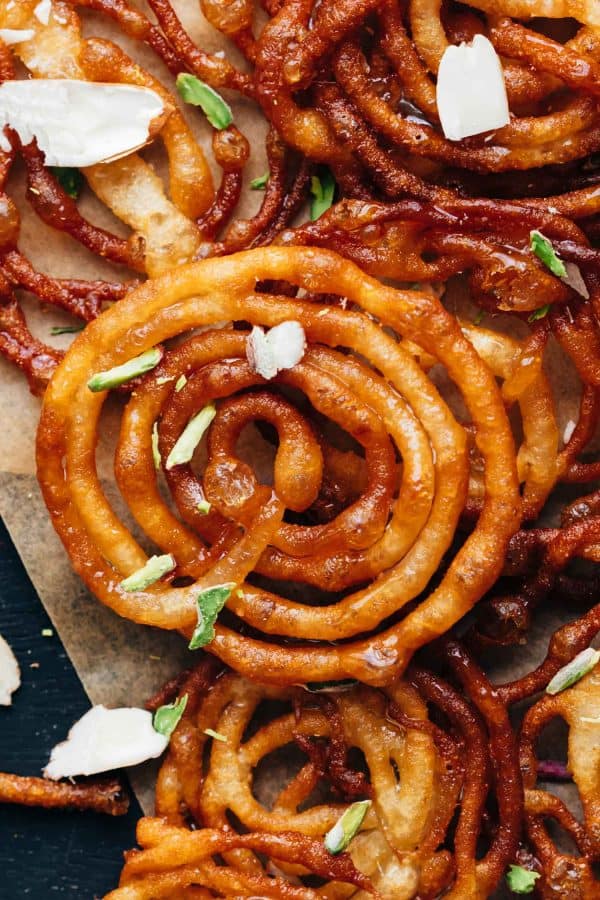
You'll know the real deal only when you make these crispy, thin jalebis at home! They are fragrant from the saffron and have a beautiful golden color that's completely natural. And that's what makes homemade jalebi so so special.
Watch how to make Jalebi recipe video
More Festive Recipes
- Chocolate Kheer
- Quinoa Apple Kheer
- The Best Samosas
- Pakodas
- Paneer Pakora
- 25 Amazing Diwali Recipes for the busy cook
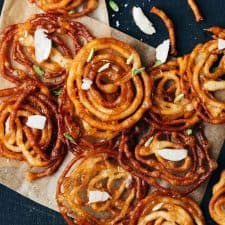
Homemade Jalebi - Thin and Crispy
Ingredients
Levain
- ¼ cup All Purpose Flour maida
- 2 tablespoons Curd yogurt
- 2 tablespoons Water
Batter:
- ¼ cup All Purpose Flour maida
- ¼ cup Water
Sugar Syrup:
- 2 cups Sugar
- 2 cups Water
- 3 tablespoons Milk to clean the syrup
- 1 teaspoon Lime juice to clean the syrup
- 12-15 Saffron strands
- 2 tablespoons Ghee preferably or Oil to fry
Instructions
- Whisk together ¼ cup flour with 2 tablespoons each of curd and water. Pour the paste into an airtight container which has enough space for the batter to rise slightly and leave in a warm, dry place overnight or even up to 2 days depending upon the weather. When ready, you will see small bubbles forming on the surface due to fermentation. This is the levain for the jalebis.
- Heat sugar and water together, stirring occasionally till the sugar dissolves. Add 3 tablespoons milk and the lime juice to this and let it boil for a couple of minutes. You will see that the milk curdles and all the impurities in the sugar will get entangled in this scum. Collect this with a slotted spoon and discard to clean the sugar syrup. Add saffron strands and let this simmer on low till the syrup reaches a temperature of 100C/212F. It shouldn't reach the one thread consistency. Keep the syrup warm on very low heat. You can add a few teaspoons of water later if you need to thin out the syrup again.
- When ready to fry the jalebis, whisk 3 tablespoons of the levain with ¼ cup of plain flour and ¼ cup of water till smooth. This batter should be of dropping consistency, neither runny nor too thick. Fill this batter into a squeezy bottle (like the one shown in the video), screw the top and leave for about 10 minutes.
- Heat ghee or oil in a flat bottomed shallow pan till it reaches 176C/350F. If you don't have a thermometer, squeeze out a drop of the batter in to the pan and if it comes up at once, then the ghee is ready to fry the Jalebis.
- Hold the bottle a few inches over the hot ghee and pipe out small concentric circles or spirals straight into the pan. You may make as many Jalebis as would fit into the pan, without touching each other. Once you finish piping, lower the heat to medium and fry the Jalebis, turning once or twice in between, till golden on both sides.
- Lift the Jalebis out of the ghee with a slotted spoon or tongs, draining out any excess ghee and put them straight into the warm sugar syrup, pressing them gently into the syrup to soak. Lift them out of the syrup after half a minute and serve immediately.
Video
Notes
- Levain: The remaining levain can be refrigerated and used again by adding more flour and water to it. Think of it as a starter. It lasts in the fridge for 3-4 days.
- Ghee vs Oil for frying: Ghee is the traditional ingredient to fry jalebis and gives it an authentic taste. But if you want, you can use a neutral flavoured vegetable oil to fry these.
- Colour: You may add food grade yellow color to the sugar syrup while boiling it if you want a bright yellow colour. But we recommend sticking to saffron, which adds a gorgeous colour and natural golden colour.
- Pouring the batter: Jalebis are traditionally made with a mold made with several layers of cloth stitched together and a small hole cut in the middle for dropping the batter into the hot ghee. This takes skill and practice, which is why we use a squeezy bottle instead.

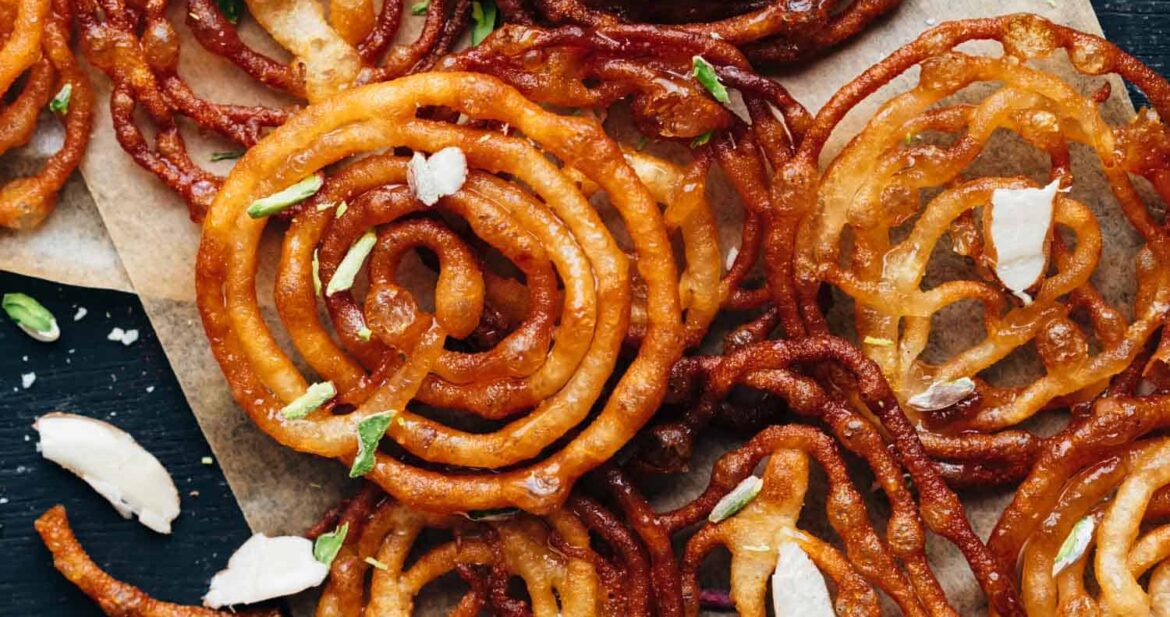
Riya Ann Varghese says
The best Indian mithai ever! So easy and stunningly delicious.. definitely making this whenever there's an occasion and whenever there's not!
Richa says
I agreee!
Pavani says
Can this levain be used to make sourdough bread?
Richa says
I don't think so
Chetna says
Tried Jalebi for the first time & I must say it was a super hit & during lockdown our family was craving for Jalebi Rabdi & I chose both recipe from ur food blog & everyone loved it. will share this post with friends & family for sure.
Richa says
Yaaay! Now you are making me crave jalebi and rabri
Anjali says
Hi Richa, I'm new to jalebi-making and I need some expert opinion on a problem I'm consistently facing: the jalebi I made turned flat at the bottom while frying and didn't plump up. I've tried three different recipes, including yours, and I can't seem to get rid of this problem. On each attempt I even fiddled around with the consistency of the batter (after a couple of flat batches) but it was the same result each time. What could potentially be causing the jalebi to turn flat?
Richa says
Hey Anjali, the flat jalebis are because the batter isn't fermented properly. You may need to keep the levain for a day longer. How long the batter takes to ferment depends on the weather where you live - warmer climate means it'll ferment faster. It should smell distinctly sour and you should even see a few small bubbles in it. Once its fermented well, your jalebis will come out light and crispy.
Ritika Raj says
This recipe of Jalebi is really good. Thanks for such amazing recipe. Please visit http://www.temptingrecipe.com
Richa says
Thank you so much! So happy you enjoyed it!
H says
Fool proof, really delish !
Richa says
Thank you sooo much